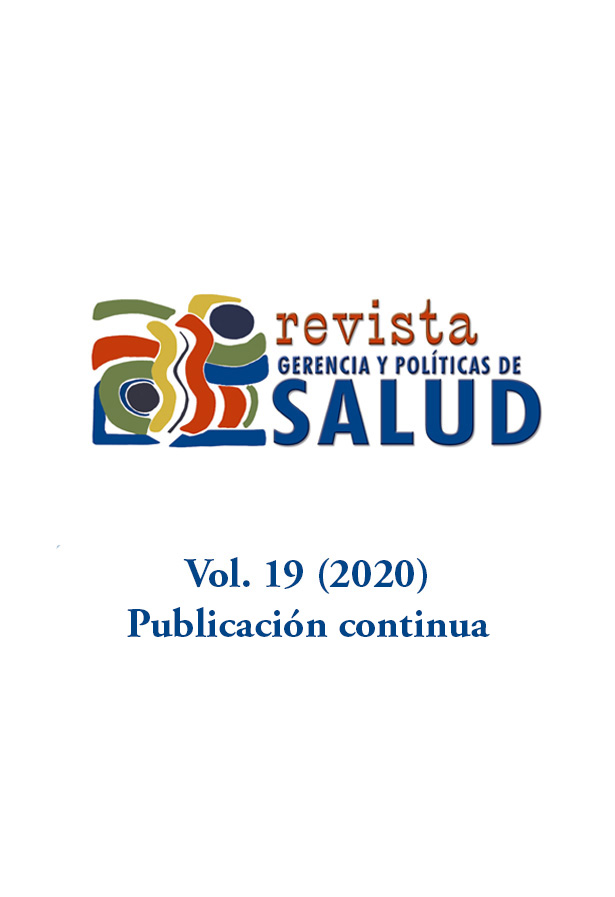Abstract
Objective: To determine the continuity in the emergency service of the state-owned hospital (ESE) ‘Hospital Regional Suroriental’ between June 01, 2016 and June 30, 2017. Methods: It is a quantitative, descriptive, cross-sectional research. The population consisted of 16,801 patients. The dependent variable was the continuity in the emergency health care service and the independent variables were age, gender, type of coverage, checkup month, triage, and time staying at the hospital. Results: Regarding the gender, most of the people going to the doctor’s office were male; regarding the age, they were children between 0-9 years; and regarding the health coverage, they were in the state-subsidized health care regime; regarding the health care priority, they were treated as triage III. Most of them were discharged after a long stay at the hospital, with highly-scattered data. Discussion: Continuity in the health care at the emergency services is affected by long stays, regardless of the triage. It indicates potential failures in the quality of health care and means some risks for the patient’s well-being and life.
2. Colombia. Ministerio de salud y Protección Social. Guías para manejo de urgencias. Tomo I. [Internet]. 2009 [revisión 2019 abr. 13]. Disponible en: https://www.minsalud.gov.co/Documentos%20y%20Publicaciones/Gu%C3%ADa%20para%20manejo%20de%20urgencias%20-Tomo%20I.pdf
3. Rodríguez-Páez FG, Jiménez-Barbosa WG, Palencia-Sánchez F. Uso de los servicios de urgencias en Bogotá, Colombia: Un análisis desde el Triaje. Univ. Salud. 2018;20(3):215-226. http://www.doi.org/10.22267/rus.182003.124
4. Durand AC, Palazzolo S, Tanti-Hardouin N, Gerbeaux P, Sambuc R, Gentile S. Nonurgent patients in emergency departments: Rational or irresponsible consumers? Perceptions of professionals and patients [Internet]. BMC Res Notes. 2012;5(525):1-9. Disponible en: http://www.biomedcentral.com/1756-0500/5/525
5. Molano-Gutiérrez FR, Escobar-Grisales CM, García-Vargas MA, Salazar-Molina PA, Mejía-Venegas LC, Jiménez-Barbosa WG. Motivos de uso de los servicios de urgencias. Acta Odontol Colomb. 2016;6(1):123-136.
6. Di Somma S, Paladino L, Vaughan L, Lalle I, Magrini L, Magnanti M. Overcrowding in emergency department: an international issue. Intern Emerg Med. 2015;10:171-175.
7. López-Pons P. Calidad, satisfacción y patologías en un servicio de urgencias [tesis doctoral]. [Madrid]: Universidad Autónoma de Madrid; 2014.
8. Manito I, Ondiviela A, Servera M, Tomás M. Estudio sobre las dificultades en la implantación y seguimiento de la continuidad asistencial entre niveles [tesis de maestría]. [Barcelona]: Escuela universitaria de enfermería Santa Madrona; 2005.
9. Colombia. Ministerio de salud y Protección Social. Decreto 1011 del 2006 [Internet]. 2006 [revisión 2019 abr. 13]. Disponible en: https://www.minsalud.gov.co/sites/rid/Lists/BibliotecaDigital/RIDE/DE/DIJ/Decreto-1011-de-2006.pdf
10. Colombia. Ministerio de salud y Protección Social. Resolución 5596 del 2005 [Internet]. 2005 [revisión 2019 mzo. 12]. Disponible en: https://www.minsalud.gov.co/sites/rid/Lists/BibliotecaDigital/RIDE/DE/DIJ/resolucion-5596-de-2015.pdf
11. E. S. E Hospital Regional Suroriental Chinácota [Internet] [revisión 2019 mzo. 09]. Disponible en: https://hospital.esesuroriental.gov.co/
12. Echandía-Castilla C, Cabrera-Nossa I. El Catatumbo (Colombia) en el posacuerdo: riesgos y oportunidades de la participación política de las FARC. Forum. 2017;12:89-112.
13. Colombia. Ministerio de Salud y Protección Social. Resolución 5596 de 2015. Bogotá: Gobierno de Colombia; 2015.
14. Paton A, Mitra B, Considine J. Longer time to transfer from the emergency department after bed request is associated with worse outcomes. Emerg Med Australas. 2019;31(2):211-215.
15. Driesen BEJM, van Riet BHG, Verkerk L, Bonjer HJ, Merten H, Nanayakkara PWB. Long length of stay at the emergency department is mostly caused by organisational factors outside the influence of the emergency department: A root cause analysis. PLoS ONE. 2018;13(9):e0202751. https://doi.org/10.1371/journal.pone.0202751
16. Johnson KD, Gillespie GL, Vance K. Effects of Interruptions on Triage Process in Emergency Department. A Prospective, Observational Study. J Nurs Care Qual. 2018;33(4):375-381.
17. Johnson KD, Motavalli M, Gray D, Kuehn C. Causes and Occurrences of Interruptions During ED Triage. J Emerg Nurs. 2013;40(5):434-439.
18. Restrepo-Zea JH, Jaén-Posada JS, Espinal Piedrahita JJ, Zapata Flórez PA. Saturación en los servicios de urgencias: Análisis de cuatro hospitales de Medellín y simulación de estrategias. Rev. Gerenc. Polit. Salud. 2018;17(34):130-144.
19. Obermeyer Z, Abujaber S, Makar M, Stoll S, Kayden SR, Wallis LA, et al. Acute Care Development Consortium. Emergency care in 59 low- and middle-income countries: a systematic review. Bull. World Health Organ. 2015;93(8):577-586G.
20. Aeimchanbanjong K, Pandee U. Validation of different pediatric triage systems in the emergency department. World J Emerg Med. 2017;8(3):223-227.
21. Latham L, Ackroyd-Stolarz S. Emergency Department Utilization by Older Adults: a Descriptive Study. Can Geriatr J. 2014;17(4):118-125.
Copyright notice
The Journal Management and Health Policies is registered under the Creative Commons Recognition 4.0 International license. Therefore, this work can be reproduced, distributed and publicly communicated in digital format, provided that the name of the authors and the Pontificia Universidad Javeriana are recognized. It is allowed to quote, adapt, transform, autoarchive, republish and create from the material, for any purpose (including commercial), provided that authorship is properly acknowledged, a link to the original work is provided and if changes have been mad. The Pontificia Universidad Javeriana does not retain the rights over published works and the contents are the exclusive responsibility of the authors, who preserve their moral, intellectual, privacy and publicity rights.
The endorsement of the intervention of the work (revision, style correction, translation, layout) and its subsequent disclosure is granted through a license to use and not through a transfer of rights, which means that the journal and the Pontificia Universidad Javeriana disclaims any liability that may arise from ethical misconduct on the part of the authors. As a result of the protection provided by the license for use, the journal is not obliged to publish retractions or modify the information already published, unless the erratum arises from the process of editorial management. The publication of contents in this magazine does not represent royalties for taxpayers.


